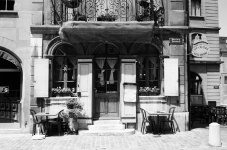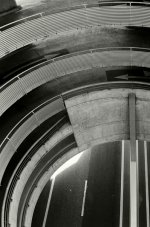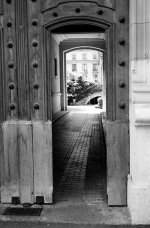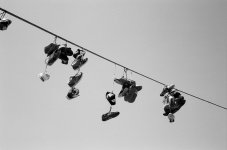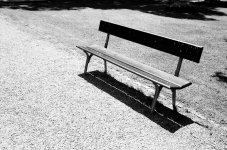Swissmadepix
Established
Good Day Everybody ! Honored to be typing something read by some fine photographers indeed.
It's been a couple of weeks that I have been lurking onto the different threads of the RFF and have already learned a lot in the progress. Please bear with me - while I introduce myself by telling how I became "addicted to light" (aka photography) - before I share my first RF experience.
After early youth years spent using anything handy - from a Kodak Instamatic to the infamous Kodak Disc camera - 4 years ago I bought my first digital P&S camera. While it was easy to learn how not to do things, thanks to the "immediate feedback" of digital, I quickly got frustrated: the more I learend about the creative and technical aspects of the combination between shutter speed and aperture, the more I was dissatisfied with my gear. I upgraded to a "full manual" fixed lens digital camera. Finally I was able to control the parameters that allowed me to "get what I wanted" in camera, rather than correcting the image in post-exposure processing (aka photoshop). After 3 years of shooting "full manual", it seems like I have developed some pleasing composition and an eye for "the right moment".
A Friend of mine thought that I have become proficient enough for asking me to cover his wedding, this upcoming July (and yes..I know..I'm crazy for having accepted..LOL).
I DO NOT WANT TO SCREW UP on such an important moment. So...3 weeks ago, I started looking for a camera that would be both backup (don't have the financial means to buy a second digital body) and complementary (I WANT that shallow DOF that a lens faster than f/2.8 can deliver). Requirements ? Easy to use, fast lens, full manual capabilities, relatively cheap yet still rugged.
The answer was almost innate: an "older" film-fed rangefinder, accepting 35mm standard rolls.
That's how I started my travel into the world of 1960 to 1980's RF cameras. I have read a lot about the subject: bodies, lenses, film types, developing, scanning...
...and I came up with my "dream setup": It includes a fixed lens RFF, a developing tank for the negs and a film scanner.
I have the first part. Found a deal on "evilbay" and purchased a Canon Canonet QL17 GIII. The finder is very clear, the lens is pristine, shutter works correctly at all speeds, the seals are OK-ish (already ordered replacement from the RFF-reputed source), the "ASA LEVER" is stuck, the light meter does not work - despite of a zinc-air cell (not important, since I use te Sunny16 & a handheld meter) - manuf date is SEP76...for less than USD50.
What put a stop to my ambitions is the cost of a scanner. I DO know that it would be a worthwile investment in the long term (develop & scan of 1 roll 35mm C-41 B/W rates at CHF27/USD20 right now) but I currently cannot put out the money for a scanner. I have experimented "IR pictures" in digital and would LOVE to do so in film (faster shutter speeds) but then...darn scanner's still too pricey ! So for the moment, I will be shooting Kodak BW400CN only. I'm currently experimenting with the filter factor my polarizing filter will give me as a ND (want to have shallow DOF even in bright conditions).
The first roll I shot and made the lab develop, yielded the results you see attached to this post (edits: slight level - resize). Would be more than grateful for any feedback. And....I am happy and glad to be "back on film".
Swissmadepix
(aka Reto)
P.S.:
today (07JUN) I just paid CHF53/USD40 for a Canonet QL17 GIII - working meter, battery OK, finder clear, lens pristine, seals definitely to be replaced.
Have I become a hopeless victim of GAS ? ...ROFL..
It's been a couple of weeks that I have been lurking onto the different threads of the RFF and have already learned a lot in the progress. Please bear with me - while I introduce myself by telling how I became "addicted to light" (aka photography) - before I share my first RF experience.
After early youth years spent using anything handy - from a Kodak Instamatic to the infamous Kodak Disc camera - 4 years ago I bought my first digital P&S camera. While it was easy to learn how not to do things, thanks to the "immediate feedback" of digital, I quickly got frustrated: the more I learend about the creative and technical aspects of the combination between shutter speed and aperture, the more I was dissatisfied with my gear. I upgraded to a "full manual" fixed lens digital camera. Finally I was able to control the parameters that allowed me to "get what I wanted" in camera, rather than correcting the image in post-exposure processing (aka photoshop). After 3 years of shooting "full manual", it seems like I have developed some pleasing composition and an eye for "the right moment".
A Friend of mine thought that I have become proficient enough for asking me to cover his wedding, this upcoming July (and yes..I know..I'm crazy for having accepted..LOL).
I DO NOT WANT TO SCREW UP on such an important moment. So...3 weeks ago, I started looking for a camera that would be both backup (don't have the financial means to buy a second digital body) and complementary (I WANT that shallow DOF that a lens faster than f/2.8 can deliver). Requirements ? Easy to use, fast lens, full manual capabilities, relatively cheap yet still rugged.
The answer was almost innate: an "older" film-fed rangefinder, accepting 35mm standard rolls.
That's how I started my travel into the world of 1960 to 1980's RF cameras. I have read a lot about the subject: bodies, lenses, film types, developing, scanning...
...and I came up with my "dream setup": It includes a fixed lens RFF, a developing tank for the negs and a film scanner.
I have the first part. Found a deal on "evilbay" and purchased a Canon Canonet QL17 GIII. The finder is very clear, the lens is pristine, shutter works correctly at all speeds, the seals are OK-ish (already ordered replacement from the RFF-reputed source), the "ASA LEVER" is stuck, the light meter does not work - despite of a zinc-air cell (not important, since I use te Sunny16 & a handheld meter) - manuf date is SEP76...for less than USD50.
What put a stop to my ambitions is the cost of a scanner. I DO know that it would be a worthwile investment in the long term (develop & scan of 1 roll 35mm C-41 B/W rates at CHF27/USD20 right now) but I currently cannot put out the money for a scanner. I have experimented "IR pictures" in digital and would LOVE to do so in film (faster shutter speeds) but then...darn scanner's still too pricey ! So for the moment, I will be shooting Kodak BW400CN only. I'm currently experimenting with the filter factor my polarizing filter will give me as a ND (want to have shallow DOF even in bright conditions).
The first roll I shot and made the lab develop, yielded the results you see attached to this post (edits: slight level - resize). Would be more than grateful for any feedback. And....I am happy and glad to be "back on film".
Swissmadepix
(aka Reto)
P.S.:
today (07JUN) I just paid CHF53/USD40 for a Canonet QL17 GIII - working meter, battery OK, finder clear, lens pristine, seals definitely to be replaced.
Have I become a hopeless victim of GAS ? ...ROFL..


